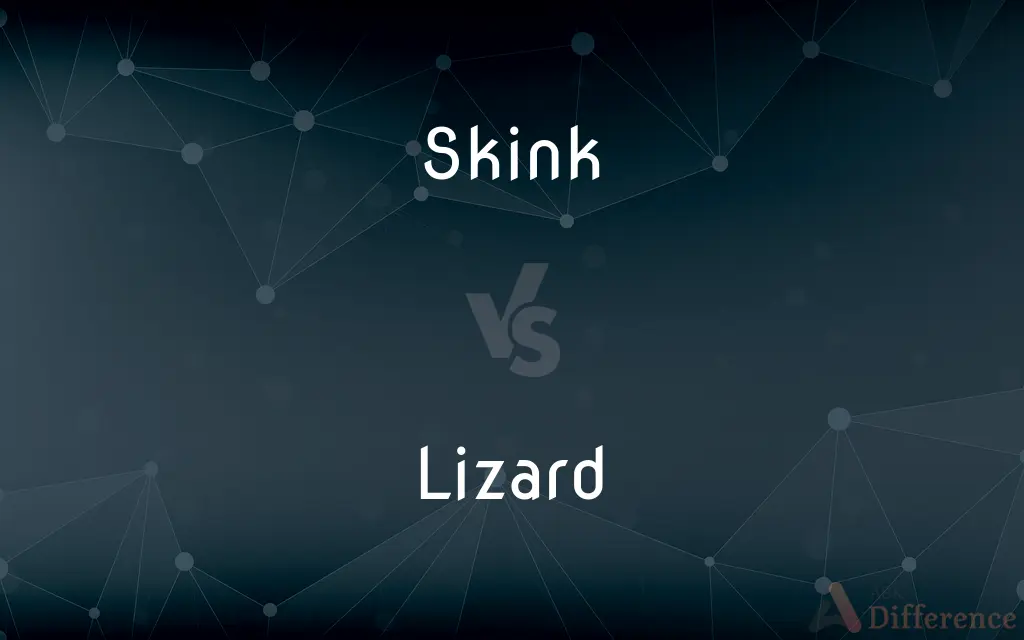Skink vs. Lizard — What's the Difference?
By Tayyaba Rehman & Maham Liaqat — Updated on March 28, 2024
Skinks are a distinct subgroup within the larger lizard family, characterized by their smoother scales and often more elongated bodies, whereas lizards encompass a wider range of species with diverse body forms and habitats.

Difference Between Skink and Lizard
Table of Contents
ADVERTISEMENT
Key Differences
Skinks are known for their sleek, smooth scales that give them a shiny appearance, often found in vibrant colors or patterns. These scales are tightly overlapped, providing a streamlined look. On the other hand, lizards can exhibit a variety of scale textures, from rough and spiny to smooth, depending on the species. This diversity in scale texture affects not only their appearance but also their adaptability to different environments.
Skinks typically have more elongated bodies with shorter legs compared to many other lizards. This body shape allows them to burrow and navigate through tight spaces with ease. In contrast, lizards display a wide range of body shapes and sizes, from the robust and hefty Komodo dragon to the slender and agile gecko, reflecting their adaptability to various niches and habitats.
The tail of a skink is a notable feature, often being as long as or longer than the rest of its body. Many skink species have the ability to detach their tail as a defense mechanism against predators. While tail autotomy is also observed in many lizard species, the extent and efficiency of this process can vary significantly, indicating a fascinating aspect of evolutionary adaptation among these reptiles.
Skinks are generally ground-dwelling creatures that prefer to stay close to the earth, where they can easily find cover and hunt for insects. Conversely, lizards encompass species that thrive in diverse environments, including trees (arboreal), deserts, and even water, showcasing the group's ecological versatility.
In terms of diet, skinks primarily feed on insects and small invertebrates, making them important for controlling pest populations. However, the dietary preferences of lizards are much more varied, with some species being herbivorous, others carnivorous, and yet others omnivorous, reflecting the ecological diversity of the group.
ADVERTISEMENT
Comparison Chart
Scale Texture
Smooth, tightly overlapped scales
Varies widely, from smooth to rough
Body Shape
Elongated bodies with shorter legs
Wide range, from slender to robust
Tail
Often as long as the body, capable of detachment
Varies, tail length and autotomy efficiency differ
Habitat
Primarily ground-dwelling
Diverse, including arboreal, desert, aquatic
Diet
Mostly insectivorous
Ranges from herbivorous, carnivorous to omnivorous
Compare with Definitions
Skink
Skinks are primarily insectivorous.
A skink was seen hunting insects in the garden, controlling the pest population.
Lizard
Lizards can be found in various habitats, including forests, deserts, and swamps.
The water dragon is adept at swimming, making rivers and lakes its preferred habitat.
Skink
They have short legs compared to their body length.
The skink moved swiftly across the forest floor, its short legs barely visible.
Lizard
Some lizard species can live in arid deserts.
The desert iguana thrives in the hot, sandy environment of the Mojave Desert.
Skink
Many skinks exhibit tail autotomy to escape predators.
The garden skink quickly detached its tail, leaving the confused predator behind.
Lizard
Their scales can be smooth, rough, or even spiny.
The spiny scales of the horned lizard help deter predators.
Skink
Skinks are smooth-scaled lizards known for their elongated bodies.
The blue-tongued skink flicked its vibrant tongue as it surveyed its surroundings.
Lizard
Lizards are a diverse group of reptiles with varying body forms.
From the tiny gecko to the mighty Komodo dragon, lizards demonstrate remarkable diversity.
Skink
Skinks are ground-dwelling reptiles.
Nestled under a rock, the skink remained hidden from overhead predators.
Lizard
Lizards' diets can range from insects to plants.
While some lizards hunt for insects, others may nibble on leaves or fruits.
Skink
Skinks are lizards belonging to the family Scincidae, a family in the infraorder Scincomorpha. With more than 1,500 described species across 100 different taxonomic genera, the family Scincidae is one of the most diverse families of lizards.
Lizard
Lizards are a widespread group of squamate reptiles, with over 6,000 species, ranging across all continents except Antarctica, as well as most oceanic island chains. The group is paraphyletic as it excludes the snakes and Amphisbaenia; some lizards are more closely related to these two excluded groups than they are to other lizards.
Skink
A smooth-bodied lizard with short or absent limbs, typically burrowing in sandy ground, and occurring throughout tropical and temperate regions.
Lizard
Any of numerous squamate reptiles often classified in the suborder Lacertilia, characteristically having a scaly elongated body with a tapering tail, four legs, movable eyelids, and external ear openings.
Skink
Any of numerous lizards of the family Scincidae, having a smooth shiny body and large scales on the head, and in some species, small or rudimentary legs.
Lizard
Leather made from the skin of one of these reptiles.
Skink
A shin of beef.
Lean sirloin, skink and pot-roast
Lizard
Any reptile of the order Squamata that is not a snake or an amphisbaenian, usually having four legs, external ear openings, movable eyelids and a long slender body and tail.
Skink
A soup or pottage made from a boiled shin of beef.
Lizard
Lizard skin, the skin of these reptiles.
Skink
Usually preceded by a descriptive word: a soup or pottage made using other ingredients.
Cullen skink
Lizard
(colloquial) An unctuous person.
Skink
A lizard of the family Scincidae, having small or reduced limbs or none at all and long tails that are regenerated when shed; a sandfish.
Lizard
(colloquial) A coward.
Skink
(obsolete) A drink.
Lizard
(rock paper scissors) A hand forming a "D" shape with the tips of the thumb and index finger touching (a handshape resembling a lizard), that beats paper and Spock and loses to rock and scissors in rock-paper-scissors-lizard-Spock.
Skink
To serve (a drink).
Lizard
(in compounds) A person who idly spends time in a specified place, especially a promiscuous female.
Lounge lizard; lot lizard; beach lizard; truck stop lizard
Skink
To give (something) as a present.
Lizard
Any one of the numerous species of reptiles belonging to the order Lacertilia; sometimes, also applied to reptiles of other orders, as the Hatteria.
Skink
Any one of numerous species of regularly scaled harmless lizards of the family Scincidæ, common in the warmer parts of all the continents.
Lizard
A piece of rope with thimble or block spliced into one or both of the ends.
Skink
Drink; also, pottage.
Lizard
A piece of timber with a forked end, used in dragging a heavy stone, a log, or the like, from a field.
Skink
To draw or serve, as drink.
Bacchus the wine them skinketh all about.
Such wine as Ganymede doth skink to Jove.
Lizard
Relatively long-bodied reptile with usually two pairs of legs and a tapering tail
Skink
To serve or draw liquor.
Lizard
A man who idles about in the lounges of hotels and bars in search of women who would support him
Skink
Alert agile lizard with reduced limbs and an elongated body covered with shiny scales; more dependent on moisture than most lizards; found in tropical regions worldwide
Common Curiosities
Can lizards live in cold climates?
While most lizards prefer warm environments, some species are adapted to live in cooler climates.
Are all skinks lizards?
Yes, all skinks are considered a type of lizard.
Do skinks have legs?
Yes, skinks have legs, but they are often shorter relative to their body length compared to other lizards.
Do all lizards have tails?
Yes, all lizards have tails, but the length and functionality can vary greatly among species.
Are skinks good for pest control?
Yes, since skinks primarily feed on insects, they can be beneficial for natural pest control.
Do lizards drink water?
Yes, lizards do drink water, though their methods of hydration can vary widely.
Can skinks climb trees?
While most skinks are ground-dwelling, some species are capable of climbing trees.
Are all lizards carnivorous?
No, lizards have diverse diets including carnivorous, herbivorous, and omnivorous species.
How do skinks differ from snakes?
Skinks have legs, although sometimes very short, and eyelids, which snakes do not have.
How do skinks communicate?
Skinks can communicate through visual displays, body postures, and sometimes vocalizations.
Do lizards have teeth?
Yes, all lizards have teeth, but the size and shape can vary depending on their diet.
Can all lizards detach their tails?
Many but not all lizard species have the ability to detach their tails as a defense mechanism.
Are lizards social animals?
Some lizard species exhibit social behaviors, but many are solitary except during breeding season.
What is the largest type of lizard?
The Komodo dragon is currently the largest known species of lizard.
Can skinks regenerate their tails?
Yes, like many lizards, skinks can regenerate their tails, though the new tail may differ in appearance.
Share Your Discovery

Previous Comparison
Interpersonal vs. Impersonal
Next Comparison
DOS vs. WindowsAuthor Spotlight
Written by
Tayyaba RehmanTayyaba Rehman is a distinguished writer, currently serving as a primary contributor to askdifference.com. As a researcher in semantics and etymology, Tayyaba's passion for the complexity of languages and their distinctions has found a perfect home on the platform. Tayyaba delves into the intricacies of language, distinguishing between commonly confused words and phrases, thereby providing clarity for readers worldwide.
Co-written by
Maham Liaqat













































